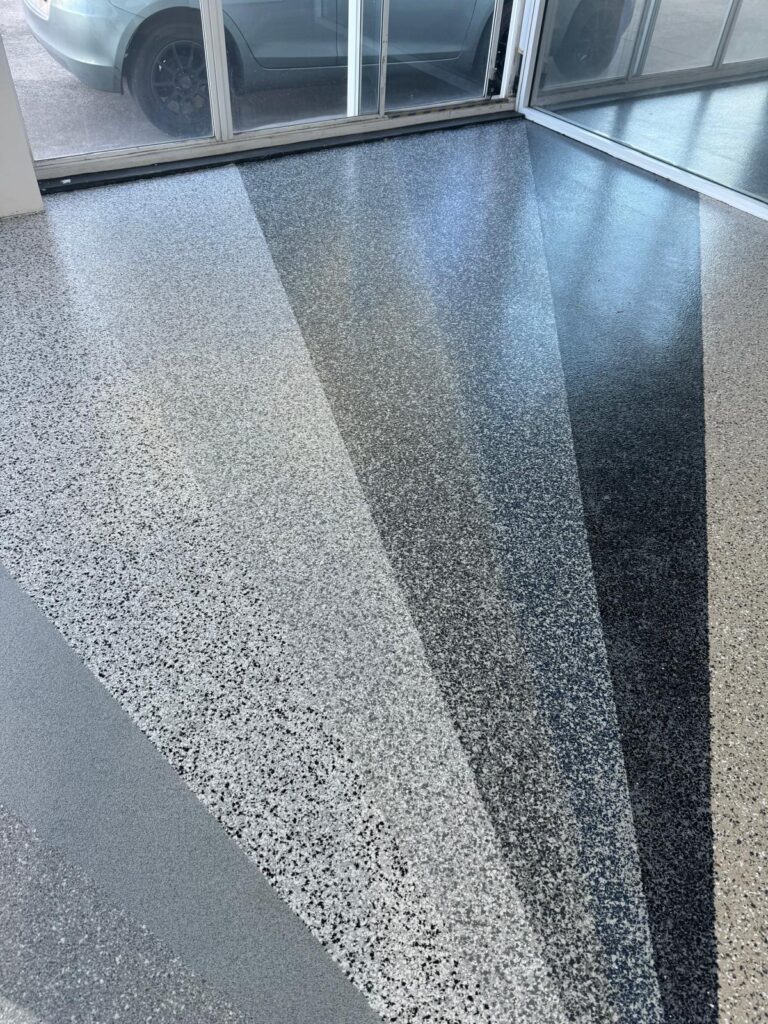
Epoxy Flake Flooring: The Ultimate Guide to Durable and Aesthetic Floors
Epoxy flake flooring is a durable and attractive flooring option that combines the strength of epoxy resin with the visual appeal of decorative flakes. The process involves applying a layer of epoxy resin and broadcasting colourful flakes onto the surface, creating a unique and customizable look. This type of flooring is highly resistant to wear, chemicals, and impact, making it an excellent choice for commercial and industrial spaces, as well as high-traffic residential areas.
Epoxy flake flooring has gained significant popularity in both residential and commercial spaces, and for good reason. This type of flooring combines durability with aesthetic appeal, making it an ideal choice for various environments. Whether you are looking to upgrade your garage, basement, or commercial space, epoxy flake flooring offers a versatile and long-lasting solution.
What is Epoxy Flake Flooring?
Epoxy flake flooring is a decorative floor coating that utilizes epoxy resin as a base layer. It involves scattering vinyl flakes or chips of different sizes, colours, and textures onto the epoxy layer, which is then sealed with a final coat of clear epoxy or polyurethane. This flooring option offers limitless customization possibilities to suit any design preference.
Benefits of Epoxy Flake Flooring
- Durability and Longevity: One of the standout features of epoxy flake flooring is its durability. The epoxy resin creates a hard, impact-resistant surface that can withstand heavy foot traffic, machinery, and even chemical spills. This makes it ideal for high-traffic areas like garages, warehouses, and industrial settings.
- Aesthetic Appeal: With a wide range of color and flake combinations, epoxy flake flooring can be tailored to suit any interior design scheme. Whether you want a sleek, modern look or a more traditional aesthetic, there is a combination that will enhance the overall appearance of your space.
- Low Maintenance: Epoxy flake flooring is incredibly easy to clean and maintain. The smooth, sealed surface resists stains, dust, and dirt, requiring only occasional sweeping and mopping to keep it looking pristine. This low-maintenance feature is particularly beneficial for busy commercial environments.
- Slip Resistance: The addition of vinyl flakes not only adds visual interest but also enhances the slip resistance of the floor. This is especially important in areas prone to spills, such as garages or commercial kitchens, where safety is a top priority.
- Cost-Effective: Compared to other flooring options like tile or hardwood, epoxy flake flooring is relatively affordable. Its durability means you won’t need to replace it frequently, providing long-term savings.
Where to Use Epoxy Flake Flooring
Epoxy flake flooring is incredibly versatile and can be used in a variety of settings:
- Garages: Protect your garage floor from oil stains, tire marks, and impact damage with epoxy flake flooring. The decorative flakes also add a touch of style to what is typically a utilitarian space.
- Basements: Transform your basement into a livable, attractive space with epoxy flake flooring. It’s an excellent option for finished basements where moisture resistance is a concern.
- Commercial Spaces: From retail stores to showrooms, epoxy flake flooring can enhance the professional appearance of any commercial space. Its durability ensures it can handle the wear and tear of daily operations.
- Industrial Settings: In warehouses, factories, and other industrial environments, epoxy flake flooring provides a resilient surface that can handle heavy equipment and chemical exposure.
How to Install Epoxy Flake Flooring
The installation process of epoxy flake flooring involves several steps to ensure a durable and attractive finish:
- Surface Preparation: The existing floor must be thoroughly cleaned and prepped. Any cracks or imperfections should be repaired, and the surface may need to be roughened to allow for better adhesion of the epoxy.
- Base Coat Application: A primer or base coat of epoxy is applied to the prepared surface. This layer acts as the foundation for the flakes and ensures a strong bond with the substrate.
- Broadcasting Flakes: While the base coat is still wet, the vinyl flakes are broadcasted onto the surface. The amount of flakes used can vary depending on the desired look, from a light sprinkle to full coverage.
- Curing: After the flakes have been applied, the floor needs time to cure. This process can take anywhere from 24 to 48 hours, depending on the product used and environmental conditions.
- Top Coat Application: Once the base layer and flakes have cured, a clear top coat of epoxy or polyurethane is applied to seal the surface. This top coat adds an extra layer of protection and gives the floor its final glossy finish.
Maintenance Tips for Epoxy Flake Flooring
To keep your epoxy flake flooring looking its best, follow these maintenance tips:
- Regular Cleaning: Sweep or vacuum regularly to remove dust and debris. For deeper cleaning, use a damp mop with a mild detergent.
- Avoid Harsh Chemicals: While epoxy floors are resistant to chemicals, it’s best to avoid using harsh cleaners that can dull the finish.
- Protect from Heavy Impacts: Place mats or pads under heavy furniture or equipment to prevent scratches or dents.
- Address Spills Immediately: Clean up any spills as soon as they occur to prevent staining or damage to the floor.
Conclusion
Epoxy flake flooring is an excellent choice for anyone looking to combine durability with aesthetic appeal. Its versatility makes it suitable for a wide range of applications, from residential garages to commercial showrooms. With proper installation and maintenance, epoxy flake flooring can provide a beautiful and resilient surface that lasts for years.
For those seeking a flooring solution that offers both style and substance, epoxy flake flooring is a top contender.
